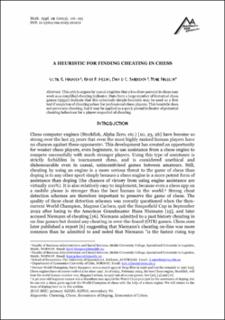| dc.contributor.author | Haugen, Kjetil K. | |
| dc.contributor.author | Heen, Knut Peder | |
| dc.contributor.author | Smerdon, David C. | |
| dc.contributor.author | Nilssen, Tore | |
| dc.date.accessioned | 2024-04-22T06:22:28Z | |
| dc.date.available | 2024-04-22T06:22:28Z | |
| dc.date.created | 2024-04-02T13:39:45Z | |
| dc.date.issued | 2023 | |
| dc.identifier.citation | Mathematics for applications. 2023, 12 (2), 116-125. | en_US |
| dc.identifier.issn | 1805-3610 | |
| dc.identifier.uri | https://hdl.handle.net/11250/3127482 | |
| dc.description.abstract | This article argues by casual empirics that a low draw percent in chess may work as a simplified cheating indicator. Data from a large number of historical chess games (53331) indicate that this extremely simple heuristic may be used as a first test if suspicion of cheating arises for professional chess players. This heuristic does not prove any cheating, but it may be applied as a quick primal indicator of potential cheating behaviour for a player suspected of cheating. | en_US |
| dc.language.iso | eng | en_US |
| dc.relation.uri | https://doi.org/10.13164/ma.2023.120212 | |
| dc.title | A heuristic for finding cheating in chess | en_US |
| dc.type | Peer reviewed | en_US |
| dc.type | Journal article | en_US |
| dc.description.version | publishedVersion | en_US |
| dc.source.pagenumber | 116-125 | en_US |
| dc.source.volume | 12 | en_US |
| dc.source.journal | Mathematics for applications | en_US |
| dc.source.issue | 2 | en_US |
| dc.identifier.doi | 10.13164/ma.2023.120212 | |
| dc.identifier.cristin | 2258104 | |
| cristin.ispublished | true | |
| cristin.fulltext | original | |
| cristin.qualitycode | 1 | |
